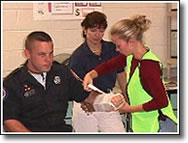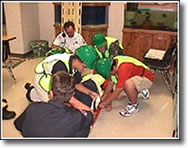Supplemental Information
Seminole County C.E.R.T. Training At Winter Springs High School
- By Jacqueline Perry, C.E.R.T. Program Developer
It is 1:14 p.m., and your children are in school - the safest place - you think. One minute ago, a tornado devastated a residential area, sideswiping the local high school! There was severe damage to half the school; unfortunately, the rescuers were unable to access the damage zone.

C.E.R.T. training has been provided to a wide variety of Seminole County School Board employees, including 35 percent of the bus drivers, many teachers, support personnel and administrators. Is this enough to guarantee a positive outcome?
Would Your Children Know What To Do in a Disaster?
Located within the center of the state, Seminole County is a prosperous, booming bedroom community with a diverse assortment of residential and professional influences. Providing C.E.R.T. training has proven to be an important contribution toward educating our citizens on how to care for themselves and their neighbors. If adults are at work or injured during a disaster, who will take care of our children? With an average of 25-40 students per class, this provides an unmanageable ratio. Would your children know what to do in a disaster situation? Could they safely take care of themselves? How would they handle a crisis, much less a major disaster?
The students in Winter Springs High School's Environmental Class have successfully completed C.E.R.T. training. These adventurous students and teachers were the first graduates of our special Pilot C.E.R.T. Program provided within the Environmental Vocational Program. Students received high school credit for learning how to help themselves and fellow students in their own environment. The teenagers are quick and eager to learn, enjoying the practical training. Even more, these trained students know their campus and community better than any administrator. Ask any student where to find something on campus; you have a very good chance of getting it if it is available. The students know who should be around an area or wing. They also know the ins and outs of the cafeteria, gymnasium, storage locations and equipment lockers.
After learning proper techniques, the students were amazed with their abilities and newfound skills. They were able to perform tasks they did not believe they could perform. The teenagers had an eye-opening experience as they crawled through a dark closet and science laboratory searching for their fallen peers. They experienced firsthand gratification as they rescued their injured classmates and brought them to safety. Many other students at the school were impressed with the young C.E.R.T. members' abilities and recently learned firefighting skills during the fire extinguisher practical, along with the "survival" first aid training.

Learning Valuable Skills And Resources To Aid Others
The teenagers learned many valuable skills and resources to aid themselves and others in the event of a disaster. The tabletop Incident Command scenario was an excellent way to learn organizing skills. These students have eagerly learned lifesaving skills that will be essential as they venture into the world. The program was tailored to provide a smooth transition into their normal class schedule, meanwhile maintaining the seven modules staggered throughout the semester, with one module as a field trip to the Emergency Operations Center for pre-disaster training. All of the remaining training, including the live fire exercise, was held at the high school so the students would experience the reality in their most probable environment. The post-disaster psychology portion of the training was somewhat altered to teach the students what is normal, expected and abnormal. Most importantly, they learned how to avoid undue stress, assist with peers and administrators, and recognize signs and symptoms of disaster-related psychological actions. This also opened the pathway to discussion about peer pressure and becoming aware of potential problems before they occur, in these troubled times of weapons in schools.
The students in the mechanic shop class really provided a life-like scenario for the triage and treatment layout portion of the EMS training. The C.E.R.T. students were surprised and stunned to see their classmates involved in an explosion. The moulage definitely brought the scene to life.
The high school program was a huge success. The C.E.R.T. Program will become a permanent part of the Environmental Vocational curriculum. We are proud of these students' hard work and eagerness to become valuable, needed resources within their community. Also, we must acknowledge the teacher for utilizing his insight to bring this training to his students and for selling the program to the school administrators. "This is an exciting new endeavor for our department and future leaders of Seminole," said Ken Roberts, Director of Public Safety.
This article is reprinted from the June 2000 issue of the IAEM Bulletin, the monthly newsletter of the International Association of Emergency Managers, with the permission of IAEM. To learn about IAEM, visit the organization's web site at http://www.iaem.com.


